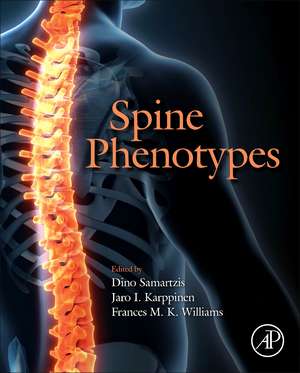Spine Phenotypes
Editat de Dino Samartzis, Jaro I. Karppinen, Frances M.K. Williamsen Limba Engleză Hardback – 13 iul 2022
Multiauthored, with multidisciplinary contributions from world leaders in the field of imaging, spine research, and clinical practice, each chapter is rich in visual depiction of imaging phenotypes, providing examples of some established phenotypic measurements with a range of normal and pathologic images and their clinical implications.
Spine Phenotypes will be a first of its kind reference for spine researchers, clinicians, and industry.
- Book chapters devoted to specific imaging phenotypes with discussion of their clinical correlates
- Imaging phenotypes provided with examples of established phenotypic measurements and a range of normal and pathologic images
- Multiauthor, multidisciplinary contributions comprising world leaders in the field of spine imaging, research, and clinical practice
Preț: 759.94 lei
Preț vechi: 989.23 lei
-23% Nou
Puncte Express: 1140
Preț estimativ în valută:
145.43€ • 150.24$ • 121.04£
145.43€ • 150.24$ • 121.04£
Carte indisponibilă temporar
Doresc să fiu notificat când acest titlu va fi disponibil:
Se trimite...
Preluare comenzi: 021 569.72.76
Specificații
ISBN-13: 9780128227787
ISBN-10: 0128227788
Pagini: 416
Ilustrații: 320 illustrations (90 in full color)
Dimensiuni: 191 x 235 x 29 mm
Greutate: 0.98 kg
Editura: ELSEVIER SCIENCE
ISBN-10: 0128227788
Pagini: 416
Ilustrații: 320 illustrations (90 in full color)
Dimensiuni: 191 x 235 x 29 mm
Greutate: 0.98 kg
Editura: ELSEVIER SCIENCE
Cuprins
1. Anatomy of the spine
2. Biomechanics of the spine
3. Biomechanical models to study spinal phenotypes
4. Animal models to study spinal intervertebral disc phenotypes
5. Imaging technologies of the spine
6. Intervertebral disc degeneration
7. Disc space narrowing and osteophytes
8. Displacement of intervertebral discs
9. High-intensity zones and annular tears
10. Vertebral endplate abnormalities, defects, and changes
11. Vertebral bone marrow (Modic) changes
12. Ossification of the posterior longitudinal ligament
13. Lumbar spinal stenosis
14. Facet joints
15. Paraspinal muscles
16. Spinal alignment
2. Biomechanics of the spine
3. Biomechanical models to study spinal phenotypes
4. Animal models to study spinal intervertebral disc phenotypes
5. Imaging technologies of the spine
6. Intervertebral disc degeneration
7. Disc space narrowing and osteophytes
8. Displacement of intervertebral discs
9. High-intensity zones and annular tears
10. Vertebral endplate abnormalities, defects, and changes
11. Vertebral bone marrow (Modic) changes
12. Ossification of the posterior longitudinal ligament
13. Lumbar spinal stenosis
14. Facet joints
15. Paraspinal muscles
16. Spinal alignment
